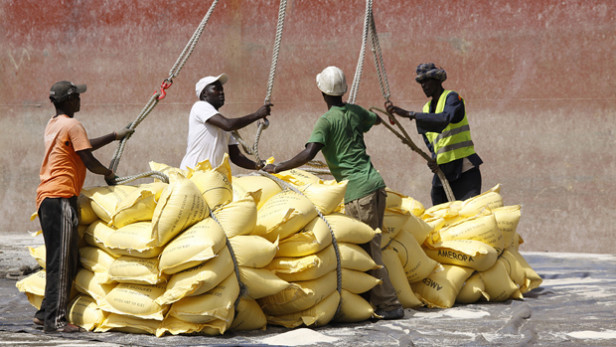 |
| Chinese rice imports at the port of Dakar, Senegal. China is exploring ways to feed its growing population using food grown in Africa. Photo by: vredeseilanden / CC BY-NC |
I wrote my first book analyzing the problems and challenges faced by Chinese rice projects in West Africa (Chinese Aid and African Development, 1998), so this is a special interest of mine. Here's what is going on in Senegal -- excerpted from an excellent analysis by Adama Wade at Financialafrik.com.
Senegal, with 13 million inhabitants, is the world’s tenth biggest importer with 700,000 to 900,000 tonnes per year. ... « It is strange that the rice produced in central Vietnam, transported to Ho Chi Min Port, loaded in bulk and shipped to the ports of Abidjan or Dakar, landed and then transported by road to Bobo Dioulasso or St. Louis is preferred by the population and is cheaper than local rice», wonders aloud an operator, formerly shareholder of Glencore International. ... Local production accounts for 200,000 tonnes of paddy rice, the equivalent of 140,000 tonnes of local rice. The Government’s goal is to reach 1 million tonnes by 2015, including 800,000 tonnes produced through irrigated rice. The Senegalese Government has made food self-sufficiency its key priority. But, there are still some inconsistencies. More tax incentives are given to investors who make 80% of their turnover from exports. Amazing! This is just the tip of the iceberg- while Asian producers receive subsidies on energy, water and fertilizers, in the Senegal River Valley, support mechanisms remain elusive. So, there are no energy subsidies for rice production and development (offset). Urea, which was subsidised by 50% between 2006 and 2011 and sold at CFAF 6,000 now costs CFAF 9,000. Although the price of DAP actually decreased, the quantity available barely covers half of the requirements. There is an energy challenge in the processing of local rice.«There are fixed monthly electricity costs. Whether you work or not, you pay CFAF 250,000 a month.» Under such conditions, can local rice sold at CFA 12,500 mill price (12,500 for whole grain rice) be competitive and generate enough income for a quantitative and qualitative leap?Adama's analysis makes it clear why the Chinese are not likely to be coming to Senegal for their rice. When it comes to that -- if it does -- they will go to Vietnam. Just as the Senegalese do.


![[GRAPHICS]CHINA-FOREIGN AID-GEOGRAPHICAL DISTRIBUTION (CN)](http://news.xinhuanet.com/english/china/2014-07/10/133474011_14049749104241n.jpg)